
REDUCE – The Board Game
Reducing your organisation’s commuter emissions isn’t automatic, but there are many tried and tested initiatives that employers can implement to reduce emissions.
Click on the Shortcuts, Diversions and Targets on the REDUCE board below to learn how you can achieve zero carbon commuting.
REDUCE – The Board Game
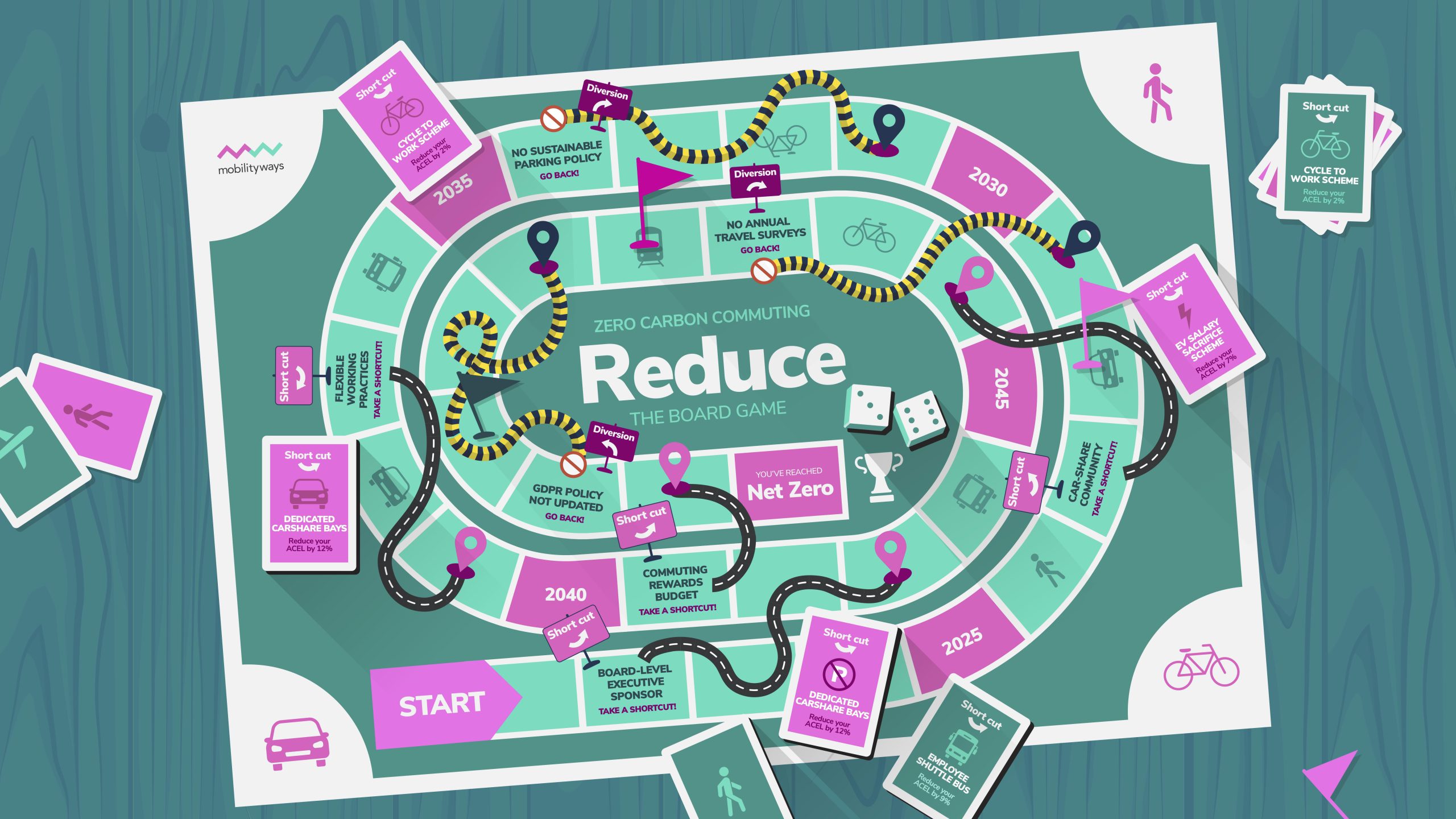

Car-Share Bays
What?
Dedicated car-share bays (or even entire car-share car parks) are parking spaces that are reserved exclusively for those that car-share.
Why?
The higher the proportion of staff parking earmarked for car-sharing, the more likely employees are to car-share. The convenience of being able to park on-site quickly outweighs the small inconvenience of car-sharing. Car-sharing allows you to more than double the capacity of your car park.
Who?
Any employee that commutes by single occupancy vehicle is a contender for switching to car-sharing. The larger the employer the more likely that potential car-sharers will find suitable partners to share with. Employers with parking constraints - where available parking spaces are lower than demand - are those that are most successful in encouraging modal-shift through car-share bays.
Potential Impact
Every commuter that switches from single occupancy vehicle to car-sharing halves their commute emissions (and fuel costs). The greater the proportion of staff car parking reserved for car-sharing, and the greater the demand for parking, the higher the modal shift. Importantly, for car-share bays to be effective they must be validated and enforced.
How?
Mobilityways is the UK's leader in car-sharing, with our Liftshare For Work solution now celebrating it's silver jubilee. We don't just provide our award-winning software, but also provide the experience and expertise to support car-sharing uptake.
Dedicated car-share bays (or even entire car-share car parks) are parking spaces that are reserved exclusively for those that car-share.
Why?
The higher the proportion of staff parking earmarked for car-sharing, the more likely employees are to car-share. The convenience of being able to park on-site quickly outweighs the small inconvenience of car-sharing. Car-sharing allows you to more than double the capacity of your car park.
Who?
Any employee that commutes by single occupancy vehicle is a contender for switching to car-sharing. The larger the employer the more likely that potential car-sharers will find suitable partners to share with. Employers with parking constraints - where available parking spaces are lower than demand - are those that are most successful in encouraging modal-shift through car-share bays.
Potential Impact
Every commuter that switches from single occupancy vehicle to car-sharing halves their commute emissions (and fuel costs). The greater the proportion of staff car parking reserved for car-sharing, and the greater the demand for parking, the higher the modal shift. Importantly, for car-share bays to be effective they must be validated and enforced.
How?
Mobilityways is the UK's leader in car-sharing, with our Liftshare For Work solution now celebrating it's silver jubilee. We don't just provide our award-winning software, but also provide the experience and expertise to support car-sharing uptake.
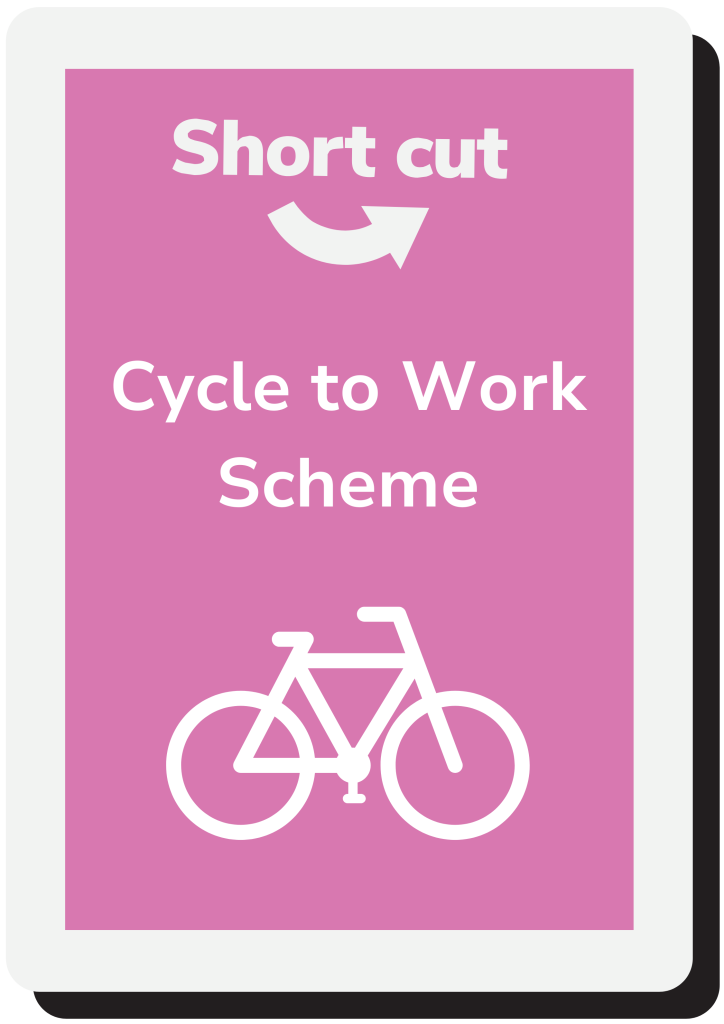
Cycle to Work
What?
A Cycle to Work scheme is an arrangement where employees agree to give up part of their salary, typically for a year, in exchange for the purchase of a bike or e-bike.
Why?
Employees benefit from reduced income tax and National Insurance contributions because their pre-tax salary is lowered and employers also save on National Insurance contributions. Cycle to Work makes it more accessible for employees to purchase more expensive bikes, including e-bikes.
Who?
Employees in higher income tax brackets receive greater financial savings from salary sacrifice. As the arrangement typically lasts a year, organisations need a stable workforce to implement Cycle to Work.
Potential Impact
Bikes have zero tailpipe emissions, therefore, anyone moving from other modes of transport to a bike become zero carbon commuters.
Whilst Cycle to Work schemes receive strong uptake - 180,000 employees a year - data is patchy on whether the scheme actually encourages modal-shift on the commute.
However, evidence is stronger that e-bikes allow employees to commute from greater distances than traditional bicycles, potentially extending how many employees can "active travel" to work. Data from Mobilityways partner DashRides shows that commuters are willing to travel up to 12 miles by e-bike, double the 6 miles for manual cyclists.
How?
Mobilityways CommuteIQ allows you to model how many of your employees have viable bike or e-bike commutes. DashRides provide the most flexible and dynamic Cycle to Work schemes.
A Cycle to Work scheme is an arrangement where employees agree to give up part of their salary, typically for a year, in exchange for the purchase of a bike or e-bike.
Why?
Employees benefit from reduced income tax and National Insurance contributions because their pre-tax salary is lowered and employers also save on National Insurance contributions. Cycle to Work makes it more accessible for employees to purchase more expensive bikes, including e-bikes.
Who?
Employees in higher income tax brackets receive greater financial savings from salary sacrifice. As the arrangement typically lasts a year, organisations need a stable workforce to implement Cycle to Work.
Potential Impact
Bikes have zero tailpipe emissions, therefore, anyone moving from other modes of transport to a bike become zero carbon commuters.
Whilst Cycle to Work schemes receive strong uptake - 180,000 employees a year - data is patchy on whether the scheme actually encourages modal-shift on the commute.
However, evidence is stronger that e-bikes allow employees to commute from greater distances than traditional bicycles, potentially extending how many employees can "active travel" to work. Data from Mobilityways partner DashRides shows that commuters are willing to travel up to 12 miles by e-bike, double the 6 miles for manual cyclists.
How?
Mobilityways CommuteIQ allows you to model how many of your employees have viable bike or e-bike commutes. DashRides provide the most flexible and dynamic Cycle to Work schemes.

EV Salary Sacrifice
What?
A salary sacrifice electric vehicle scheme is an arrangement where employees agree to give up part of their salary in exchange for the lease of an electric vehicle.
Why?
EVs are typically more expensive to buy than their ICE (internal-combustion engine) equivalents. The tax advantages of salary sacrifice make it significantly more affordable to lease an EV. Employees benefit from reduced income tax and National Insurance contributions because their pre-tax salary is lowered and employers also save on National Insurance contributions.
Who?
Employees in higher income tax brackets receive greater financial savings from salary sacrifice. As EV leases are typically 2-5 years, a scheme is best suited to organisations with stable well-paid workforces. For employers that are attempting to reduce single occupancy vehicles, EVs are not a solution!
Potential Impact
EVs have (almost!) zero tailpipe emissions, therefore, anyone moving from an ICE vehicle to an EV becomes a zero carbon commuter. Encouraging uptake of EVs will drastically reduce an organisation's commuter emissions. Our data shows that large employers can see 9-10% of their staff lease EVs within 3 years of launching a salary sacrifice EV schemes
How?
Mobilityways works closely with the UK's most innovative EV provider - OctopusEV.
A salary sacrifice electric vehicle scheme is an arrangement where employees agree to give up part of their salary in exchange for the lease of an electric vehicle.
Why?
EVs are typically more expensive to buy than their ICE (internal-combustion engine) equivalents. The tax advantages of salary sacrifice make it significantly more affordable to lease an EV. Employees benefit from reduced income tax and National Insurance contributions because their pre-tax salary is lowered and employers also save on National Insurance contributions.
Who?
Employees in higher income tax brackets receive greater financial savings from salary sacrifice. As EV leases are typically 2-5 years, a scheme is best suited to organisations with stable well-paid workforces. For employers that are attempting to reduce single occupancy vehicles, EVs are not a solution!
Potential Impact
EVs have (almost!) zero tailpipe emissions, therefore, anyone moving from an ICE vehicle to an EV becomes a zero carbon commuter. Encouraging uptake of EVs will drastically reduce an organisation's commuter emissions. Our data shows that large employers can see 9-10% of their staff lease EVs within 3 years of launching a salary sacrifice EV schemes
How?
Mobilityways works closely with the UK's most innovative EV provider - OctopusEV.
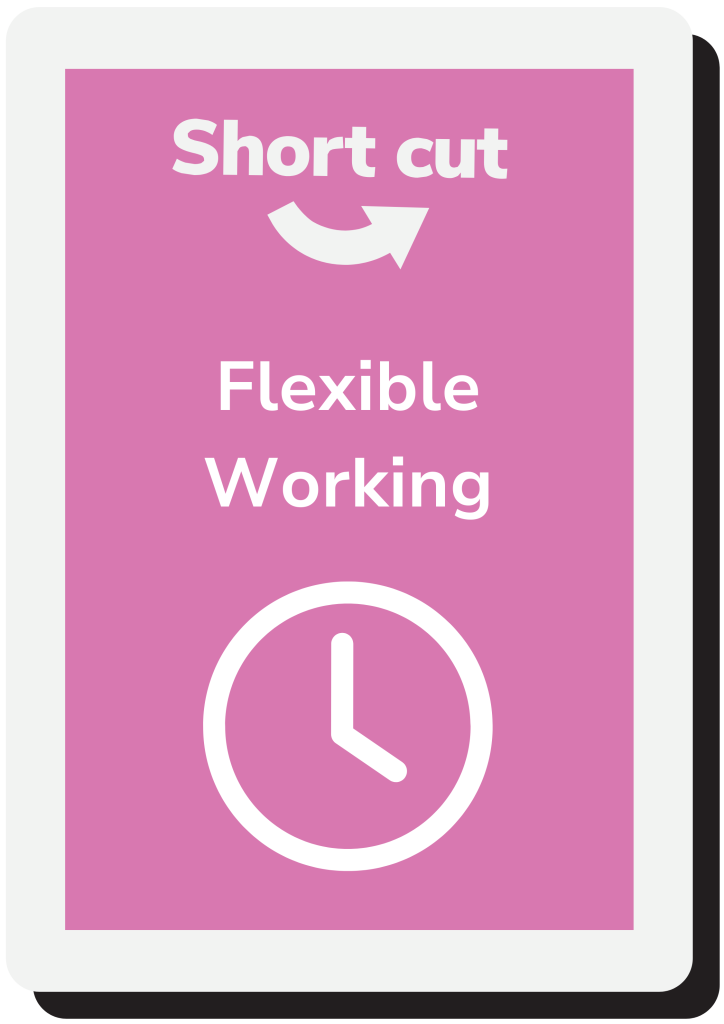
Flexible Work
What?
Flexible work includes work arrangement where employees have variability in their working hours, locations, or patterns, allowing them to balance their work commitments with personal life.
Why?
Where employees are afforded greater flexibility in working hours, it can support them in choosing sustainable commute modes. For example, by allowing employee to align their working day with bus and train schedules. Additionally, allowing employees to work from home more exclusively or in hybrid with on-site eliminates the commute entirely.
Who?
Flexible working is not suitable for every employer, for example organisations that have multiple shifts throughout the day. Typically, employees with desk jobs are those most able to work from home.
Potential Impact
Every commuter that switches from single occupancy vehicle to a more sustainable transport mode, or stops commuting entirely will reduce commute emissions and car park occupancy.
How?
Engaging with your team is the starting point to understanding their sentiment towards flexible working. Using Mobilityways CommuteIQ we can model the impact of different shift patterns on access to sustainable transport.
Flexible work includes work arrangement where employees have variability in their working hours, locations, or patterns, allowing them to balance their work commitments with personal life.
Why?
Where employees are afforded greater flexibility in working hours, it can support them in choosing sustainable commute modes. For example, by allowing employee to align their working day with bus and train schedules. Additionally, allowing employees to work from home more exclusively or in hybrid with on-site eliminates the commute entirely.
Who?
Flexible working is not suitable for every employer, for example organisations that have multiple shifts throughout the day. Typically, employees with desk jobs are those most able to work from home.
Potential Impact
Every commuter that switches from single occupancy vehicle to a more sustainable transport mode, or stops commuting entirely will reduce commute emissions and car park occupancy.
How?
Engaging with your team is the starting point to understanding their sentiment towards flexible working. Using Mobilityways CommuteIQ we can model the impact of different shift patterns on access to sustainable transport.

Commute Rewards
What?
From competitions and prizes to regular rewards and incentives, there are endless ways that employers can reward employees for choosing more sustainable commutes.
Why?
Decarbonising the commute requires participation from your team. They need to be willing and committed to change their behaviours. By incentivising them with rewards for choosing sustainable travel it supports their willingness to participate.
Who?
Any employee that has a viable sustainable alternative to single occupancy vehicle commuting can be incentivised to change their behaviour. This could be encouraging them to car-share, use public transport or cycle to work.
Potential Impact
Every commuter that switches from single occupancy vehicle to car-sharing halves their commute emissions (and fuel costs). The greater the proportion of staff car parking reserved for car-sharing, and the greater the demand for parking, the higher the modal shift. Importantly, for car-share bays to be effective they must be validated and enforced.
How?
Rewards and incentives could range from short-term competitions (e.g. prizes for those that cycle to work during Bike Week), or could be on-going(e.g. every time someone car-shares to work they receive free parking). Mobilityways has pioneered a flexible rewards system to encourage sustainable commuting, called CommuteBoost .
From competitions and prizes to regular rewards and incentives, there are endless ways that employers can reward employees for choosing more sustainable commutes.
Why?
Decarbonising the commute requires participation from your team. They need to be willing and committed to change their behaviours. By incentivising them with rewards for choosing sustainable travel it supports their willingness to participate.
Who?
Any employee that has a viable sustainable alternative to single occupancy vehicle commuting can be incentivised to change their behaviour. This could be encouraging them to car-share, use public transport or cycle to work.
Potential Impact
Every commuter that switches from single occupancy vehicle to car-sharing halves their commute emissions (and fuel costs). The greater the proportion of staff car parking reserved for car-sharing, and the greater the demand for parking, the higher the modal shift. Importantly, for car-share bays to be effective they must be validated and enforced.
How?
Rewards and incentives could range from short-term competitions (e.g. prizes for those that cycle to work during Bike Week), or could be on-going(e.g. every time someone car-shares to work they receive free parking). Mobilityways has pioneered a flexible rewards system to encourage sustainable commuting, called CommuteBoost .

Executive Sponsor
What?
An executive sponsor is a senior leader within your organisation who advocates for and supports initiatives aimed at promoting zero carbon commuting among employees.
Why?
Having an executive sponsor for zero carbon commuting initiatives ensures that the programme receives the necessary visibility, resources, and support at the highest levels of the organisation. Additionally, it can drive buy-in across the team.
Who?
An empowered senior leader is the best executive sponsor. The more senior, the better!
Potential Impact
When your senior leaders are talking about net zero your team knows that it’s genuinely important. For example, when the Chief Executive is the person emailing the organization to launch a Travel Survey the response rate will be far higher than if the email comes from a junior administrator.
The number one thing a strong executive sponsor brings is urgency!
An executive sponsor is a senior leader within your organisation who advocates for and supports initiatives aimed at promoting zero carbon commuting among employees.
Why?
Having an executive sponsor for zero carbon commuting initiatives ensures that the programme receives the necessary visibility, resources, and support at the highest levels of the organisation. Additionally, it can drive buy-in across the team.
Who?
An empowered senior leader is the best executive sponsor. The more senior, the better!
Potential Impact
When your senior leaders are talking about net zero your team knows that it’s genuinely important. For example, when the Chief Executive is the person emailing the organization to launch a Travel Survey the response rate will be far higher than if the email comes from a junior administrator.
The number one thing a strong executive sponsor brings is urgency!

Car-Share Bays
What?
Dedicated car-share bays (or even entire car-share car parks) are parking spaces that are reserved exclusively for those that car-share.
Why?
The higher the proportion of staff parking earmarked for car-sharing, the more likely employees are to car-share. The convenience of being able to park on-site quickly outweighs the small inconvenience of car-sharing. Car-sharing allows you to more than double the capacity of your car park.
Who?
Any employee that commutes by single occupancy vehicle is a contender for switching to car-sharing. The larger the employer the more likely that potential car-sharers will find suitable partners to share with. Employers with parking constraints - where available parking spaces are lower than demand - are those that are most successful in encouraging modal-shift through car-share bays.
Potential Impact
Every commuter that switches from single occupancy vehicle to car-sharing halves their commute emissions (and fuel costs). The greater the proportion of staff car parking reserved for car-sharing, and the greater the demand for parking, the higher the modal shift. Importantly, for car-share bays to be effective they must be validated and enforced.
How
Mobilityways is the UK's leader in car-sharing, with our Liftshare For Work solution now celebrating it's silver jubilee. We don't just provide our award-winning software, but also provide the experience and expertise to support car-sharing uptake.
Dedicated car-share bays (or even entire car-share car parks) are parking spaces that are reserved exclusively for those that car-share.
Why?
The higher the proportion of staff parking earmarked for car-sharing, the more likely employees are to car-share. The convenience of being able to park on-site quickly outweighs the small inconvenience of car-sharing. Car-sharing allows you to more than double the capacity of your car park.
Who?
Any employee that commutes by single occupancy vehicle is a contender for switching to car-sharing. The larger the employer the more likely that potential car-sharers will find suitable partners to share with. Employers with parking constraints - where available parking spaces are lower than demand - are those that are most successful in encouraging modal-shift through car-share bays.
Potential Impact
Every commuter that switches from single occupancy vehicle to car-sharing halves their commute emissions (and fuel costs). The greater the proportion of staff car parking reserved for car-sharing, and the greater the demand for parking, the higher the modal shift. Importantly, for car-share bays to be effective they must be validated and enforced.
How
Mobilityways is the UK's leader in car-sharing, with our Liftshare For Work solution now celebrating it's silver jubilee. We don't just provide our award-winning software, but also provide the experience and expertise to support car-sharing uptake.
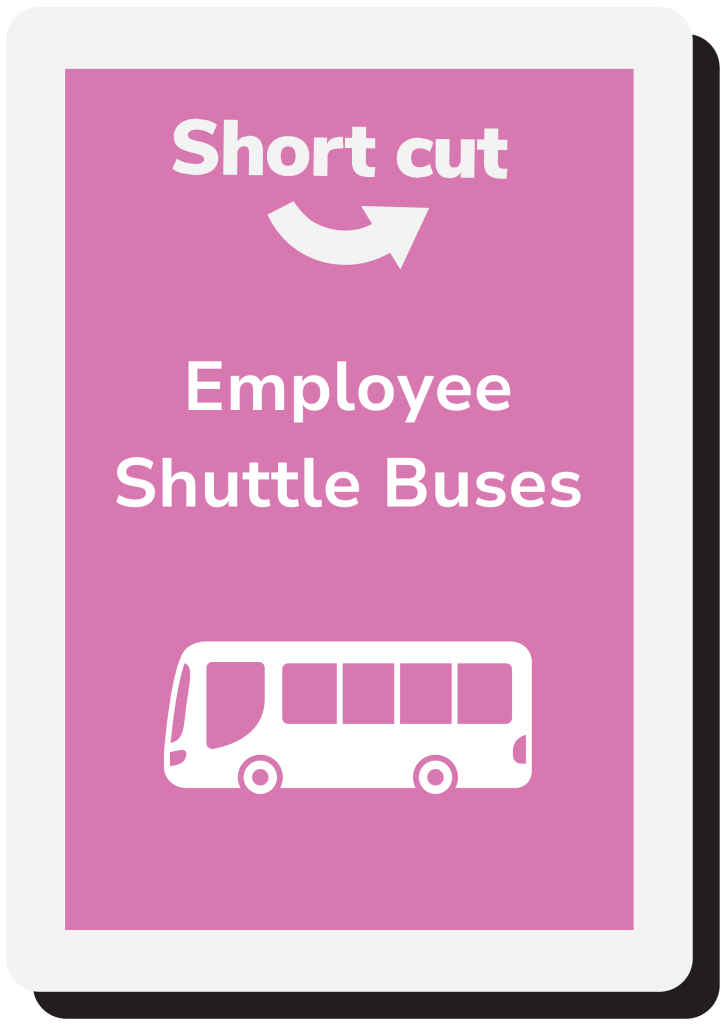
Employee Shuttle Bus
What?
Employee shuttle buses, sometimes called vanpooling, is where an employer organises dedicated buses to get their staff to site.
Why?
Shuttle buses work well to fill gaps in public transport provision and where other sustainable commuting modes (like cycling) are not viable. Additionally, some employers choose to use shuttle buses to subsidise travel costs for employees.
Who?
Any large employer where employees struggle to access their workplace, particularly if they work consistent hours, is a strong contender for shuttle buses.
Potential Impact
Impact varies depending on the occupancy of the shuttle bus and whether shuttle buses are electric. The greatest impact is where an employee transitions from single occupancy vehicle commuting to an electric shuttle bus. Importantly, shuttle bus users not only reduce their CO2e impact, they also reduce car parking requirements.
How?
Mobilityways CommuteIQ can model the viablity of shuttle buses for your employees, as well as identifying the key target routes with gaps in existing public transport provision. Mobilityways works closely with UK's leader in employee shuttle buses, Zeelo.
Employee shuttle buses, sometimes called vanpooling, is where an employer organises dedicated buses to get their staff to site.
Why?
Shuttle buses work well to fill gaps in public transport provision and where other sustainable commuting modes (like cycling) are not viable. Additionally, some employers choose to use shuttle buses to subsidise travel costs for employees.
Who?
Any large employer where employees struggle to access their workplace, particularly if they work consistent hours, is a strong contender for shuttle buses.
Potential Impact
Impact varies depending on the occupancy of the shuttle bus and whether shuttle buses are electric. The greatest impact is where an employee transitions from single occupancy vehicle commuting to an electric shuttle bus. Importantly, shuttle bus users not only reduce their CO2e impact, they also reduce car parking requirements.
How?
Mobilityways CommuteIQ can model the viablity of shuttle buses for your employees, as well as identifying the key target routes with gaps in existing public transport provision. Mobilityways works closely with UK's leader in employee shuttle buses, Zeelo.

Annual Travel Surveys
What?
Annual employee travel surveys allow you to gain insight from your team on their commuting behaviours and sentiment. The data is used to calculate your commuter emissions as well as providing key insights into the modes, frequency and distances your team are travelling to work.
Why?
Commuter emissions form part of your organisation’s scope 3 emissions. It’s important that you calculate your emissions regularly to understand what progress you are making towards achieving your net zero goals.
Who?
An empowered senior leader is the best executive sponsor. The more senior, the better!
Potential Impact
“What gets measured gets managed”- if you’ve not got regular data on your current commuting emissions it’s impossible to develop reliable reduction plans, or validate that you’re on track.
How
Mobilityways are the UK’s leader in Travel Surveys. Our purpose-built tools will automatically convert your Travel Survey data in a Commute Emissions Calculation.
Annual employee travel surveys allow you to gain insight from your team on their commuting behaviours and sentiment. The data is used to calculate your commuter emissions as well as providing key insights into the modes, frequency and distances your team are travelling to work.
Why?
Commuter emissions form part of your organisation’s scope 3 emissions. It’s important that you calculate your emissions regularly to understand what progress you are making towards achieving your net zero goals.
Who?
An empowered senior leader is the best executive sponsor. The more senior, the better!
Potential Impact
“What gets measured gets managed”- if you’ve not got regular data on your current commuting emissions it’s impossible to develop reliable reduction plans, or validate that you’re on track.
How
Mobilityways are the UK’s leader in Travel Surveys. Our purpose-built tools will automatically convert your Travel Survey data in a Commute Emissions Calculation.

Parking Policy
What?
Your organisation’s commuting policies, particularly your parking policies, can be incredible tools for promoting sustainable commuting.
Why?
By developing sustainability-first parking policies you can encourage your employees to choose more sustainable commutes, for example by prioritising those that car-share and encouraging active travel.
Who?
Any large employer who controls their own carpark should be able to refine their parking policy to better support zero carbon commuting. This is especially the case in situations where there are parking constraints.
Potential Impact
Many large employers currently issue parking permits based upon seniority or on a first-come-first-served basis. However, by approaching it from a site-access and availability of alternative sustainable transport options, it's possible to radically change an organisation's commute emissions. Mobilityways clients have experienced over-night reductions of 20% in commute emissions simply by adapting their parking policies.
How?
The Mobilityways Consultant Commutology team supports employers in improving their commute policies to best support sustainability. We have also partnered with Octopass to provide Sustainable Cark Park Management - a sustainability-first approach to parking permit issuance.
Your organisation’s commuting policies, particularly your parking policies, can be incredible tools for promoting sustainable commuting.
Why?
By developing sustainability-first parking policies you can encourage your employees to choose more sustainable commutes, for example by prioritising those that car-share and encouraging active travel.
Who?
Any large employer who controls their own carpark should be able to refine their parking policy to better support zero carbon commuting. This is especially the case in situations where there are parking constraints.
Potential Impact
Many large employers currently issue parking permits based upon seniority or on a first-come-first-served basis. However, by approaching it from a site-access and availability of alternative sustainable transport options, it's possible to radically change an organisation's commute emissions. Mobilityways clients have experienced over-night reductions of 20% in commute emissions simply by adapting their parking policies.
How?
The Mobilityways Consultant Commutology team supports employers in improving their commute policies to best support sustainability. We have also partnered with Octopass to provide Sustainable Cark Park Management - a sustainability-first approach to parking permit issuance.

GDPR Policy
What?
Large employers are obligated to be diligent in how they handle employee data. In your employee privacy policy will be details of how you process employee personal data for purposes like payroll and HR. However, when many employee GDPR privacy policies were written they did not cover commuting data.
Why?
To decarbonise the commute, it’s essential that you’re able to process some employee personal data (for example their home addresses) in order to provide accurate modelling and forecasting. By incorporating these use-cases into your privacy policies can provide transparency for your team and future-proof your internal policies.
Who?
All employers should review their employee privacy policies to include details about processing employee commute data for the purpose of calculating and reducing CO2e emissions.
How?
Mobilityways have supported many large employers in processing employee data. We regularly hold webinars on GDPR best practice for analysing the commute.
Large employers are obligated to be diligent in how they handle employee data. In your employee privacy policy will be details of how you process employee personal data for purposes like payroll and HR. However, when many employee GDPR privacy policies were written they did not cover commuting data.
Why?
To decarbonise the commute, it’s essential that you’re able to process some employee personal data (for example their home addresses) in order to provide accurate modelling and forecasting. By incorporating these use-cases into your privacy policies can provide transparency for your team and future-proof your internal policies.
Who?
All employers should review their employee privacy policies to include details about processing employee commute data for the purpose of calculating and reducing CO2e emissions.
How?
Mobilityways have supported many large employers in processing employee data. We regularly hold webinars on GDPR best practice for analysing the commute.
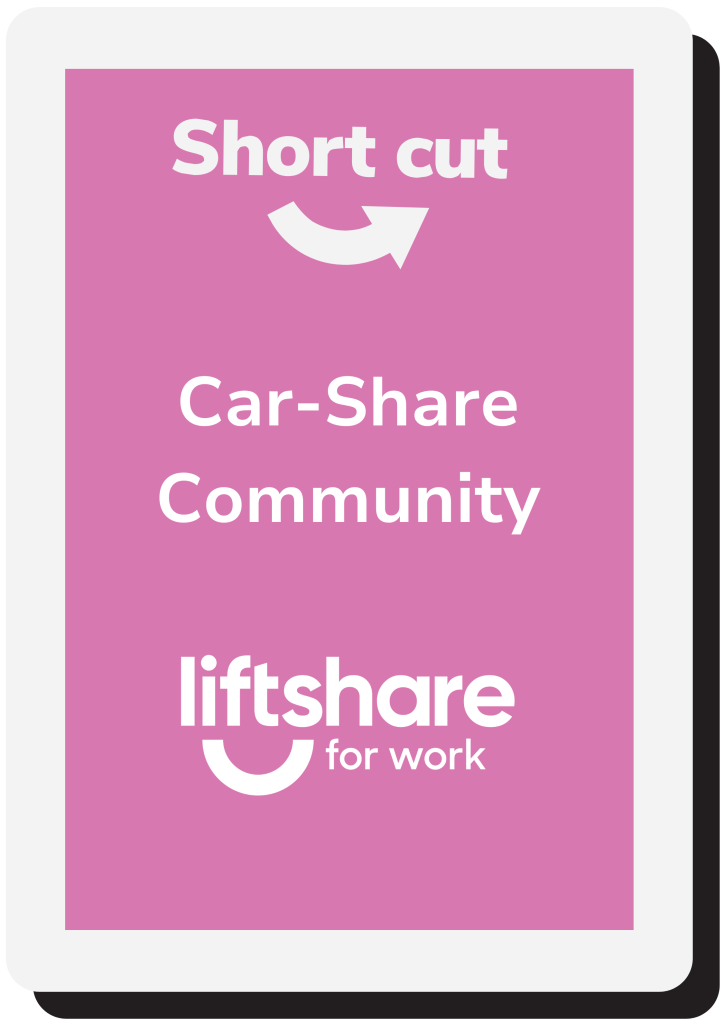
Car-Share Community
What?
Sometimes also called carpooling, liftsharing or ride-sharing, a car-share community is a software platform to help colleagues connect with those that share similar commutes.
Why?
Giving colleagues a lift to work has been happening organically for as long as people have had cars. However, at a certain scale - around 200 employees - it is no longer possible for the entire organisation to know everyone else personally. At scale a car-share community allows employees from different teams and departments to find car-share partners.
Who?
Any employee that commutes by single occupancy vehicle is a contender for switching to car-sharing. The larger the employer the more likely that potential car-sharers will find suitable partners to share with.
Potential Impact
Every commuter that switches from single occupancy vehicle to car-sharing halves their commute emissions (and fuel costs). The greater the proportion of staff car parking reserved for car-sharing, and the greater the demand for parking, the higher the modal shift. Importantly, for car-share bays to be effective they must be validated and enforced.
How?
Mobilityways is the UK's leader in car-sharing, with our Liftshare For Work solution now celebrating it's silver jubilee. We don't just provide our award-winning software, but also provide the experience and expertise to support car-sharing uptake.
Sometimes also called carpooling, liftsharing or ride-sharing, a car-share community is a software platform to help colleagues connect with those that share similar commutes.
Why?
Giving colleagues a lift to work has been happening organically for as long as people have had cars. However, at a certain scale - around 200 employees - it is no longer possible for the entire organisation to know everyone else personally. At scale a car-share community allows employees from different teams and departments to find car-share partners.
Who?
Any employee that commutes by single occupancy vehicle is a contender for switching to car-sharing. The larger the employer the more likely that potential car-sharers will find suitable partners to share with.
Potential Impact
Every commuter that switches from single occupancy vehicle to car-sharing halves their commute emissions (and fuel costs). The greater the proportion of staff car parking reserved for car-sharing, and the greater the demand for parking, the higher the modal shift. Importantly, for car-share bays to be effective they must be validated and enforced.
How?
Mobilityways is the UK's leader in car-sharing, with our Liftshare For Work solution now celebrating it's silver jubilee. We don't just provide our award-winning software, but also provide the experience and expertise to support car-sharing uptake.

Cycle to Work
What?
A Cycle to Work scheme is an arrangement where employees agree to give up part of their salary, typically for a year, in exchange for the purchase of a bike or e-bike.
Why?
Employees benefit from reduced income tax and National Insurance contributions because their pre-tax salary is lowered and employers also save on National Insurance contributions. Cycle to Work makes it more accessible for employees to purchase more expensive bikes, including e-bikes.
Who?
Employees in higher income tax brackets receive greater financial savings from salary sacrifice. As the arrangement typically lasts a year, organisations need a stable workforce to implement Cycle to Work.
Potential Impact
Bikes have zero tailpipe emissions, therefore, anyone moving from other modes of transport to a bike become zero carbon commuters.
Whilst Cycle to Work schemes receive strong uptake - 180,000 employees a year - data is patchy on whether the scheme actually encourages modal-shift on the commute.
However, evidence is stronger that e-bikes allow employees to commute from greater distances than traditional bicycles, potentially extending how many employees can "active travel" to work. Data from Mobilityways partner DashRides shows that commuters are willing to travel up to 12 miles by e-bike, double the 6 miles for manual cyclists.
How?
Mobilityways CommuteIQ allows you to model how many of your employees have viable bike or e-bike commutes. DashRides provide the most flexible and dynamic Cycle to Work schemes.
A Cycle to Work scheme is an arrangement where employees agree to give up part of their salary, typically for a year, in exchange for the purchase of a bike or e-bike.
Why?
Employees benefit from reduced income tax and National Insurance contributions because their pre-tax salary is lowered and employers also save on National Insurance contributions. Cycle to Work makes it more accessible for employees to purchase more expensive bikes, including e-bikes.
Who?
Employees in higher income tax brackets receive greater financial savings from salary sacrifice. As the arrangement typically lasts a year, organisations need a stable workforce to implement Cycle to Work.
Potential Impact
Bikes have zero tailpipe emissions, therefore, anyone moving from other modes of transport to a bike become zero carbon commuters.
Whilst Cycle to Work schemes receive strong uptake - 180,000 employees a year - data is patchy on whether the scheme actually encourages modal-shift on the commute.
However, evidence is stronger that e-bikes allow employees to commute from greater distances than traditional bicycles, potentially extending how many employees can "active travel" to work. Data from Mobilityways partner DashRides shows that commuters are willing to travel up to 12 miles by e-bike, double the 6 miles for manual cyclists.
How?
Mobilityways CommuteIQ allows you to model how many of your employees have viable bike or e-bike commutes. DashRides provide the most flexible and dynamic Cycle to Work schemes.

Net Zero
What is a Net Zero date?
Net Zero means that an organisation has reduced or mitigated through carbon offsetting all of the carbon emissions in their value chain.
Many organisations have made a public committment to achieving net zero by a certain published target year.
Learn more about the basics of Net Zero in our free Commutology 101 training.
Net Zero means that an organisation has reduced or mitigated through carbon offsetting all of the carbon emissions in their value chain.
Many organisations have made a public committment to achieving net zero by a certain published target year.
Learn more about the basics of Net Zero in our free Commutology 101 training.

Start
"The best time to plant a tree was 30 years ago, the second best time is now"
The longer your organisation delays decarbonsing your commute emissions, the steeper the challenge to achieve a Net Zero target date becomes.
Zero carbon commuting requires engagement and commitment from both employers and employees.
Learn more about the basics of Net Zero in our free Commutology 101 training.
The longer your organisation delays decarbonsing your commute emissions, the steeper the challenge to achieve a Net Zero target date becomes.
Zero carbon commuting requires engagement and commitment from both employers and employees.
Learn more about the basics of Net Zero in our free Commutology 101 training.

2025 Net Zero Target
What is a Net Zero date?
A published target date by which an organisation will have reduced their carbon emissions as much as possible, and where any unavoidable residual CO2 is offset.
Who?
Only a handful of SMEs have been able to set 2025 net zero targets - it's simply too near for large employers to adapt that quickly.
A published target date by which an organisation will have reduced their carbon emissions as much as possible, and where any unavoidable residual CO2 is offset.
Who?
Only a handful of SMEs have been able to set 2025 net zero targets - it's simply too near for large employers to adapt that quickly.

2045 Net Zero Target
What is a Net Zero date?
A published target date by which an organisation will have reduced their carbon emissions as much as possible, and where any unavoidable residual CO2 is offset.
Who?
The UK's largest employer - NHS England - has a statutory target to achieve Net Zero by 2045. Additionally, the entire public sector in Scotland also has a 2045 Net Zero target.
A published target date by which an organisation will have reduced their carbon emissions as much as possible, and where any unavoidable residual CO2 is offset.
Who?
The UK's largest employer - NHS England - has a statutory target to achieve Net Zero by 2045. Additionally, the entire public sector in Scotland also has a 2045 Net Zero target.

2030 Net Zero Target
What is a Net Zero date?
A published target date by which an organisation will have reduced their carbon emissions as much as possible, and where any unavoidable residual CO2 is offset.
Who?
For large employers, 2030 is an aggressive target for Net Zero, requiring rapid behaviour change. Trailblazers include the Welsh Government, which has set a target of Net Zero by 2030.
A published target date by which an organisation will have reduced their carbon emissions as much as possible, and where any unavoidable residual CO2 is offset.
Who?
For large employers, 2030 is an aggressive target for Net Zero, requiring rapid behaviour change. Trailblazers include the Welsh Government, which has set a target of Net Zero by 2030.

2035 Net Zero Target
What is a Net Zero date?
A published target date by which an organisation will have reduced their carbon emissions as much as possible, and where any unavoidable residual CO2 is offset.
Who?
The UK is committed to a completely Net Zero electricity system by 2035.
A published target date by which an organisation will have reduced their carbon emissions as much as possible, and where any unavoidable residual CO2 is offset.
Who?
The UK is committed to a completely Net Zero electricity system by 2035.

2040 Net Zero Target
What is a Net Zero date?
A published target date by which an organisation will have reduced their carbon emissions as much as possible, and where any unavoidable residual CO2 is offset.
Who?
There are many large employers who have committed to a 2040 Net Zero target, for example, Sainsburys and Aviva.
A published target date by which an organisation will have reduced their carbon emissions as much as possible, and where any unavoidable residual CO2 is offset.
Who?
There are many large employers who have committed to a 2040 Net Zero target, for example, Sainsburys and Aviva.
Want to learn which REDUCE tactics would work for your situation? Book a free consultation!
Get in touch now
Tell us a little more about your company, and we’ll call you back.